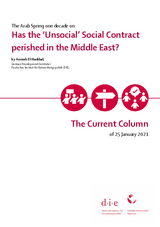The Current Column
The Arab Spring one decade on
Has the ‘Unsocial’ Social Contract perished in the Middle East?
El-Haddad, AmirahThe Current Column (2021)
German Development Institute / Deutsches Institut für Entwicklungspolitik (DIE), The Current Column of 25 January 2021
A decade ago, the streets of Tunisia, Egypt, Libya, Yemen, Syria and Bahrain sounded to the voice of youth yearning for life, freedom, dignity and social justice. Longing for opportunities in decent jobs, they took to the streets in rejection of the prevailing ‘unsocial’ social contract. This ‘unsocial’ social contract had failed to deliver the earlier generous deliverables of the populist social contract of jobs, free education and healthcare; gradually excluding more and more social groups from shaping the social contract. The legitimacy of the state was worn away by weak economic opportunities, increasing inequality and blatant favouritism. A decade later, are the forces that instigated the Arab Spring still brewing? Have inequality and social justice improved?
The massive and growing informal sector in most Middle East and North African (MENA) countries is a manifestation of continuing inequality. Currently, over 70 percent of the total labour force of Egypt and Morocco is employed in the informal economy, with Tunisia slightly less at 63%.
But what fuelled informalisation and led to the emergence of the ‘unsocial’ social contract? First, in many MENA countries the major instrument of privilege were barriers to entry into crony dominated market segments, restricting competition and private sector development whilst allowing regime supporters to make excessive profits. In Morocco, cronies were mainly politicians and owners of the diversified business groups of holding companies with strong connections to the royal court and the King. Tunisia’s cronies were the extended family businesses of Ben Ali and his wife. In Egypt, they were businesses politically connected to the government with direct access to policy formation. Protected markets resulted in the ‘missing middle’ phenomenon, in which there is a concentration of very old mostly large firms on the one hand and of large numbers of very small informal firms on the other. What was missing were innovative young firms which grow to create jobs. The political system was thus responsible for the highest rates of youth unemployment worldwide and sustained growth in informality.
Secondly, with the market-oriented reforms, MENA governments placed cuts on public sector hiring in the 1990s and freezes in the 2000s. Employment lost in the public sector could not be absorbed by the captured private sector, so retrenched workers and new labour market entrants joined the informal sector, or became unemployed. The poor cannot afford to be unemployed and so join the ranks of the informal economy. Of all employed, informal sector participants are the least privileged. Informal jobs are low-skill, low-pay, concentrated in sectors such as agriculture, construction, street vending and low value added services especially of rural migrants. They are unstable, limit human capital development opportunities and thus wage progression, creating an inertia known as the informality trap. Evidence from Egypt shows that this unregulated sector responded dramatically to these competitive pressures with the lowest wages falling even further, resulting in increased wage inequality. Moreover, the sector created jobs for the masses that are excluded from formality. Because informal sector workers are unable to form unions or associations to protest their grievances, the sector implicitly helped stabilize the regime prior to the eruption of the Arab Spring.
Since the Arab Spring, inequalities of income and wealth have increased remarkably. Social services have declined as the better off turn to private health and education providers. The situation is exacerbated by rising living costs reflected in increased inflation. More generally, factors that are beyond the control of youth – such as family wealth, their parents’ level of education, where they live, their gender – play an increasingly large role in determining their access to the services necessary for them to succeed in life, like education or running water. Inequality of opportunity is rising, yet there has been no economic transformation to date.
Politically, the trajectory of the social contract post-Arab Spring has differed in the three countries. In Egypt, the ‘unsocial’ social contract has been further entrenched. The army’s growing engagement in the economy makes it an interested party rather than an impartial arbiter. In Morocco, the King retains a prime position but has accommodated some pressures for a more inclusive industrial policy in domestic markets, which may lay the basis for a more broadly based social contract. Tunisia is finding its way to an even more inclusive development model, but is still struggling for consensus for a clear economic policy direction.
Ten years into the Arab Spring, economic changes to the benefit of the masses have been uneven. Making the ‘unsocial’ contract more social requires a transformation which distances the state from regime cronies, creating benefits for both informal workers and the unemployed. Whether the changes to date in Tunisia and Morocco are sufficient to effect such deep social change is doubtful, though not entirely hopeless. Political leaders need to believe there is a credible threat of another Arab Spring and to respond to this threat with reform rather than repression.


